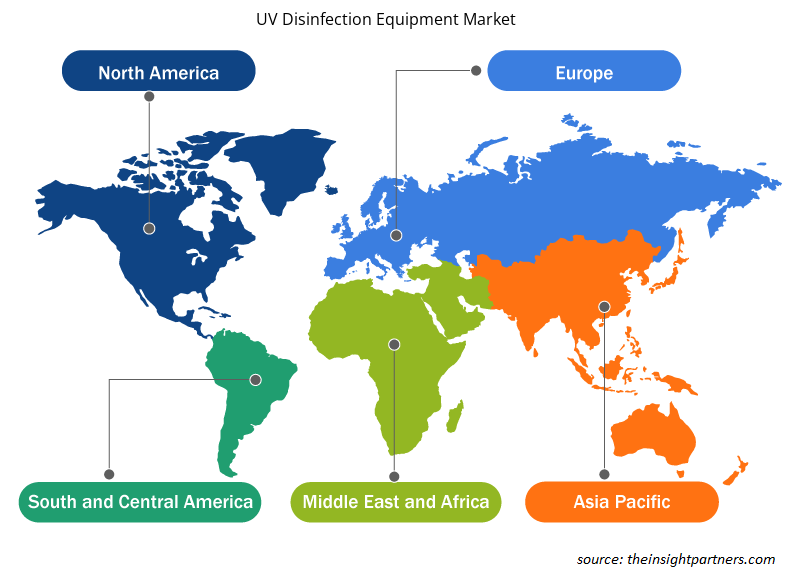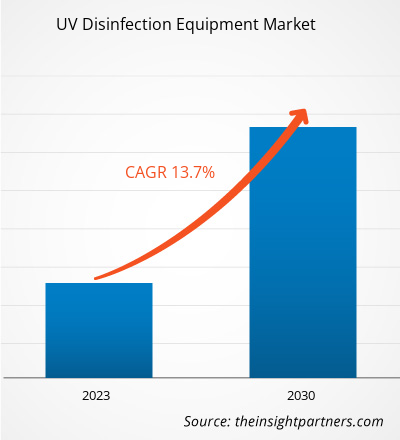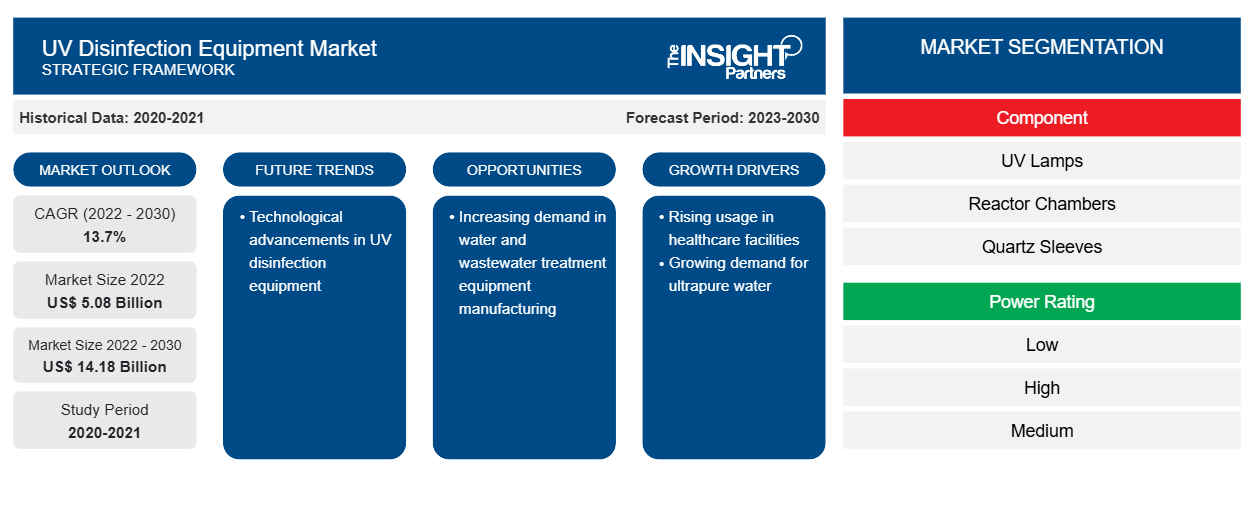[Forschungsbericht] Der Markt für UV-Desinfektionsgeräte wurde im Jahr 2022 auf 5,08 Milliarden US-Dollar geschätzt und soll bis 2030 14,18 Milliarden US-Dollar erreichen; für den Zeitraum 2023–2030 wird ein durchschnittliches jährliches Wachstum von 13,7 % erwartet.
Perspektive eines Marktanalysten für UV-Desinfektionsgeräte:
Der Markt für ultraviolette (UV) Desinfektionsgeräte in Nordamerika ist in die USA, Kanada und Mexiko unterteilt. Seit den frühen 1970er Jahren ist sauberes Wasser ein nationales Anliegen. Der Federal Water Pollution Control Act (allgemein bekannt als Clean Water Act) wurde 1972 vom US-Kongress verabschiedet, um die Gewässer des Landes zu schützen. Aufgrund dieses Gesetzes sind die US-Umweltschutzbehörde (EPA) und vergleichbare staatliche Behörden befugt, Aktivitäten zu regulieren, die die Wasserressourcen des Landes gefährden. Der Federal Water Pollution Control Act etablierte eine umfassende nationale Wasserstrategie und ein nationales Ziel, den Schadstoffeinfluss in schiffbare Gewässer zu beseitigen. Infolgedessen tragen die Versuche der Regierung, technologisch fortschrittliche, chemikalienfreie und umweltfreundliche Desinfektionsgeräte einzuführen, zum Wachstum des nordamerikanischen Marktes für UV-Desinfektionsgeräte bei . Darüber hinaus investieren die Regierungen nordamerikanischer Länder in die Förderung ihrer Fertigungsindustrien. Im Januar 2021 kündigte der US-Präsident die Initiative „Made in America“ an, die sich auf einen technologisch fortschrittlichen und automatisierten Fertigungssektor konzentriert. Mit dieser Initiative investiert die Bundesregierung in Unternehmen des Fertigungssektors und bietet ihnen Anreize, was die Nachfrage nach UV-Desinfektionsgeräten zur Verbesserung der Anlagensicherheit ankurbeln soll.
Marktübersicht für UV-Desinfektionsgeräte:
In den USA sind die gestiegenen Bedenken hinsichtlich Hygiene und Sicherheit, insbesondere in der Gesundheits- und Lebensmittelbranche, aufgrund der COVID-19-Pandemie sowie einer alternden Bevölkerung die Hauptfaktoren, die das Wachstum des Gesundheitssektors vorantreiben. Nach Schätzungen der Centers for Disease Control and Prevention (CDC) im Jahr 2019 sind im Gesundheitswesen erworbene Infektionen (HAIs) für etwa 1,7 Millionen Infektionen und 99.000 damit verbundene Todesfälle pro Jahr verantwortlich. Die US-Regierung ergreift verschiedene Maßnahmen, um die Ausbreitung von Infektionskrankheiten zu bekämpfen. Laut CDC haben bis November 2019 36 Bundesstaaten und der District of Columbia (DC) Gesetze zur Prävention und Meldung von HAIs verabschiedet. Daher steigt die Nachfrage nach UV-Desinfektionsgeräten in der gesamten Region. Darüber hinaus haben die steigenden Verschmutzungswerte und die zunehmende Verbreitung von durch die Luft übertragenen Krankheiten in den USA das Bewusstsein der Verbraucher geschärft und die Nachfrage nach UV-Desinfektionsgeräten zur Luftreinigung erhöht.
Passen Sie diesen Bericht Ihren Anforderungen an
Sie erhalten kostenlos individuelle Anpassungen an jedem Bericht, einschließlich Teilen dieses Berichts oder einer Analyse auf Länderebene, eines Excel-Datenpakets sowie tolle Angebote und Rabatte für Start-ups und Universitäten.
-
Holen Sie sich die wichtigsten Markttrends aus diesem Bericht.Dieses KOSTENLOSE Beispiel umfasst eine Datenanalyse von Markttrends bis hin zu Schätzungen und Prognosen.
Markttreiber für UV-Desinfektionsgeräte:
Steigende Nachfrage nach Reinstwasser treibt Wachstum des Marktes für UV-Desinfektionsgeräte voran
Ultrareines Wasser enthält nur H2O-Moleküle sowie Wasserstoff- und Hydroxylionen (H+ und OH-) im Gleichgewicht. Es wird verarbeitet, um strenge Anforderungen zu erfüllen und alle anderen Ionen als die oben genannten zu eliminieren. UV-Desinfektionssysteme werden verwendet, um den Gesamtgehalt an organischem Kohlenstoff (TOC) zu senken, Chlor/Chloramin und Ozon zu eliminieren und die mikrobielle Belastung des Wassers zu verringern. UV-basierte Desinfektionssysteme werden aufgrund ihrer Effizienz, Zuverlässigkeit und kurzen Betriebszeit bevorzugt, um ultrareines Wasser zu erhalten . Ultrareines Wasser findet wichtige Anwendung in der Pharmaindustrie, der Solarphotovoltaik, der Herstellung von Halbleiterbauelementen und der Stromerzeugung. Es wird verwendet, um Dampf zum Antrieb von Dampfturbinen in der Stromindustrie zu erzeugen.
Ultrareines Wasser wird in Halbleiterfabriken als Reinigungsmittel verwendet, um Mikrochip-Ausfälle zu verhindern. Laut Semiconductor Industry Association (SIA) stiegen die weltweiten Umsätze der Halbleiterindustrie im April 2023 im Vergleich zum März 2023 um 0,3 %. Daher steigt die Nachfrage nach ultrareinem Wasser mit dem Fortschritt der Halbleiterindustrie. Ein Anstieg der Nachfrage nach ultrareinem Wasser in verschiedenen Branchen begünstigt daher das Wachstum des Marktes für UV-Desinfektionsgeräte.
Marktbericht für UV-Desinfektionsgeräte – Prognose und Segmentanalyse:
In Bezug auf die Anwendung ist der Marktforschungsbericht für UV-Desinfektionsgeräte in Wasserdesinfektion, Luftdesinfektion und Oberflächendesinfektion unterteilt. Das Segment Wasserdesinfektion dominierte den Markt für UV-Desinfektionsgeräte im Jahr 2022 und wird seine Dominanz voraussichtlich bis 2030 beibehalten. UV-Desinfektionsgeräte werden aufgrund ihrer Vorteile gegenüber anderen Methoden zunehmend in Wasserdesinfektionssystemen eingesetzt. Die UV-Desinfektion ist ein chemikalienfreier Prozess zum Abtöten von Mikroorganismen, einschließlich Bakterien, Viren und Protozoen. Es ist eine hochwirksame Desinfektionsmethode und erzeugt keine schädlichen Nebenprodukte. Verschiedene Hersteller von UV-Desinfektionsgeräten bieten Produkte zur Wasserdesinfektion an. So brachte TOYODA GOSEI Co., Ltd im Februar 2023 eine kompakte Ultraviolett-C (UV-C) LED-Wasserreinigungseinheit auf den Markt. UV-C-LEDs, die Bakterien und Viren wirksam beseitigen. Die UV-C-LED-Wasserreinigungseinheit ist mit „WOSH“ ausgestattet – einem tragbaren Waschtisch mit Wasserzirkulation. Das Gerät nutzt das darin fließende Wasser, um die von den LEDs abgegebene Wärme abzukühlen. Dadurch wird die Anzahl der Teile zur Wärmeableitung reduziert und das Gerät wird kompakter. Die oben genannten Faktoren unterstützen somit das Wachstum des Marktes für UV-Desinfektionsgeräte.
Regionale Marktanalyse für UV-Desinfektionsgeräte:
Nach Angaben der kanadischen Regierung ist Abwasser aufgrund der raschen Industrialisierung die größte Verschmutzungsquelle für Oberflächenwasser in Kanada. In Kanada hat die wachsende Bevölkerung den Bedarf an sauberem, sicherem Trinkwasser erhöht. Die meisten Abwassersysteme sind Eigentum von Kommunen und werden von ihnen betrieben, die für die Verwaltung der Sammlung, Behandlung und Ableitung von Abwasser verantwortlich sind. Die Regierung verwaltet auch die Risiken, die von Stoffen ausgehen, die im kanadischen Umweltschutzgesetz von 1999 (CEPA 1999) aufgeführt sind. Darüber hinaus hat der kanadische Umweltministerrat im August 2020 die kommunale Abwasserstrategie abgerufen. Die abgerufene Strategie zielt darauf ab, die Abwasserbehandlung nach der gesamten Zeit zu überprüfen. Daher erfordert das Bewusstsein für die Abwasserbehandlung den Einsatz von UV-Desinfektionsgeräten und vergrößert den Markt für UV-Desinfektionsgeräte im Land.
UV-Desinfektionsgeräte-Marktunternehmen/Key Player-Analyse:
Der Markt für UV-Desinfektionsgeräte wurde anhand der Leistungen von Unternehmen wie Xylem Inc, Trojan Technologies Group ULC, Halma Plc, Kuraray Co Ltd, Atlantic Ultraviolet Corp, Advanced UV Inc, American Ultraviolet Inc, Atlantium Technologies Ltd, Dr. Honle AG und Evergreen UV LLC analysiert.
Regionale Einblicke in den Markt für UV-Desinfektionsgeräte
Die regionalen Trends und Faktoren, die den Markt für UV-Desinfektionsgeräte im Prognosezeitraum beeinflussen, wurden von den Analysten von Insight Partners ausführlich erläutert. In diesem Abschnitt werden auch die Marktsegmente und die Geografie für UV-Desinfektionsgeräte in Nordamerika, Europa, im asiatisch-pazifischen Raum, im Nahen Osten und Afrika sowie in Süd- und Mittelamerika erörtert.

- Erhalten Sie regionale Daten zum Markt für UV-Desinfektionsgeräte
Umfang des Marktberichts zu UV-Desinfektionsgeräten
| Berichtsattribut | Details |
|---|---|
| Marktgröße im Jahr 2022 | 5,08 Milliarden US-Dollar |
| Marktgröße bis 2030 | 14,18 Milliarden US-Dollar |
| Globale CAGR (2022 - 2030) | 13,7 % |
| Historische Daten | 2020-2021 |
| Prognosezeitraum | 2023–2030 |
| Abgedeckte Segmente |
Nach Komponente
|
| Abgedeckte Regionen und Länder |
Nordamerika
|
| Marktführer und wichtige Unternehmensprofile |
|
Dichte der Marktteilnehmer für UV-Desinfektionsgeräte: Auswirkungen auf die Geschäftsdynamik verstehen
Der Markt für UV-Desinfektionsgeräte wächst rasant, angetrieben durch die steigende Nachfrage der Endnutzer aufgrund von Faktoren wie sich entwickelnden Verbraucherpräferenzen, technologischen Fortschritten und einem größeren Bewusstsein für die Vorteile des Produkts. Mit steigender Nachfrage erweitern Unternehmen ihr Angebot, entwickeln Innovationen, um die Bedürfnisse der Verbraucher zu erfüllen, und nutzen neue Trends, was das Marktwachstum weiter ankurbelt.
Die Marktteilnehmerdichte bezieht sich auf die Verteilung der Firmen oder Unternehmen, die in einem bestimmten Markt oder einer bestimmten Branche tätig sind. Sie gibt an, wie viele Wettbewerber (Marktteilnehmer) in einem bestimmten Marktraum im Verhältnis zu seiner Größe oder seinem gesamten Marktwert präsent sind.
Die wichtigsten auf dem Markt für UV-Desinfektionsgeräte tätigen Unternehmen sind:
- Xylem Inc
- Trojan Technologies Group ULC
- Halma Plc
- Kuraray Co Ltd
- Atlantic Ultraviolet Corp
Haftungsausschluss : Die oben aufgeführten Unternehmen sind nicht in einer bestimmten Reihenfolge aufgeführt.

- Überblick über die wichtigsten Akteure auf dem Markt für UV-Desinfektionsgeräte
Aktuelle Entwicklungen auf dem Markt für UV-Desinfektionsgeräte:
Anorganische und organische Strategien wie Fusionen und Übernahmen werden von Unternehmen auf dem Markt für UV-Desinfektionsgeräte häufig eingesetzt. Nachfolgend sind einige aktuelle wichtige Marktentwicklungen aufgeführt.
- Im Jahr 2023 erwarb Xylem Inc. Evoqua Water Technologies Corp. in einer reinen Aktientransaktion im Wert von rund 7,5 Milliarden US-Dollar. Durch die Kombination entsteht die weltweit fortschrittlichste Plattform zur Bewältigung kritischer Wasserprobleme von Kunden und Gemeinden.
- Im Jahr 2019 brachte Xylem ein neues UV-Desinfektionssystem als Lösung für Aquakulturbetriebe in Salzwasser und anderen rauen Wasserbedingungen auf den Markt. Das neue Ultraviolett-Desinfektionssystem (UV) Wedeco Action PE, das auf der Aqua Nor 2019-Konferenz vorgestellt wurde, ist auf Desinfektionsraten von über 99,99 % ausgelegt.
- Im Jahr 2019 hat die Atlantic Ultraviolet Corporation (AUV) eine anwendungsspezifische Seite auf Ultraviolet.com für Personen eingerichtet, die Warnmeldungen zum Abkochen von Wasser erhalten. Diese Seite ist der vierte Teil einer Reihe neuer anwendungsspezifischer Seiten auf Ultraviolet.com, die Informationen zur Verwendung von UV-C zur chemikalienfreien Desinfektion in bestimmten Anwendungen bieten.
- Im Jahr 2018 schloss Kuraray Co., Ltd. die Übernahme der Calgon Carbon Corporation ab. Calgon Carbon wird zusammen mit Kurarays Carbon Material Business Division als Teil der Functional Materials Company von Kuraray ausgewiesen. Die Functional Materials Company umfasst die Methacrylate Division und die Medical Division.
- Historische Analyse (2 Jahre), Basisjahr, Prognose (7 Jahre) mit CAGR
- PEST- und SWOT-Analyse
- Marktgröße Wert/Volumen – Global, Regional, Land
- Branchen- und Wettbewerbslandschaft
- Excel-Datensatz
Aktuelle Berichte
Erfahrungsberichte
Grund zum Kauf
- Fundierte Entscheidungsfindung
- Marktdynamik verstehen
- Wettbewerbsanalyse
- Kundeneinblicke
- Marktprognosen
- Risikominimierung
- Strategische Planung
- Investitionsbegründung
- Identifizierung neuer Märkte
- Verbesserung von Marketingstrategien
- Steigerung der Betriebseffizienz
- Anpassung an regulatorische Trends























 Kostenlose Probe anfordern für - Markt für UV-Desinfektionsgeräte
Kostenlose Probe anfordern für - Markt für UV-Desinfektionsgeräte